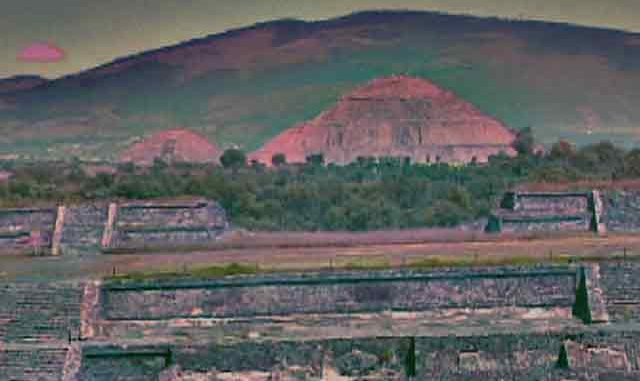
As the lightning flashes around the house here in San Miguel de Allende, I count the seconds before the thunder strikes; it’s coming closer. Another downpour in the dry season?
Up here at 3000 Meters the Mexican Antiplano is a temperate semi-desert. The most common local wild fruit being the red prickly ‘pears’ of the ‘Tuna’ cactus. But this area wasn’t always so dry. Just two or three millennia ago the Olmecs (~1000 BC) then the Teotihuacános lived in a more fertile region. Now in our calendar year 2003 the rapidly changing weather patterns send us strange unseasonable storms from the Gulf long after the wet season should have ended.
As a visitor I’m intrigued by the variety of civilizations that have lived here in the silver mining district of central Mexico. Yesterday I drove south through the filthy smog and slums of Mexico City to check out some of the remains of just one such people; the Teotihuacános. Their city, now a ruin, lies in a valley near the lake of Texcoco just an hour by car or bus for the 25 million inhabitants of Mexico City.
What the people of the great deserted city called themselves, or their city, we may never discover. The name ‘Teotihuacán’ is a Nahuatl word — the language of the warlike Aztec race — defeated by Cortés in the 1500’s; it means “city of the men who become Gods”. The Aztecs found the great deserted city of Teotihuacán in about 1250 AD some 300 years after it had been mysteriously sacked and deserted.
One Aztec legend portrays the last great meeting of the Gods in the ruins of Teotihuacán in about 100 AD. An eclipse required the creation of a new sun, the fifth sun since the creation of the world. At least two Gods were required to compete for the honor of ending the darkness. A bellicose God named Tecuziztecatl was the only volunteer so the organizers chose a little syphilitic God, Nanauatzin, volunteering him as a challenger. Before they faced their challenge each sat atop one of the two giant Teotihuacán pyramids where I too sat yesterday. Nanauatzin proved his mettle by diving into flames without fear thereby winning the right to become the world’s fifth sun. Tecuziztecatl had to settle for becoming the new moon.
Why Teotihuacán was sacked and deserted in 200 AD is still a mystery but ongoing excavations reveal a civilization that spanned a Millenium. It’s pyramids of the moon and the sun were wonders of the ancient world on this side of the Atlantic. The sun pyramid is still the third largest pyramid in the world. The Teotihuacáno priests destroyed all traces of a wonderful civilization dispersing the population to oblivion. Why this happened is anyone’s guess but the denuded hillsides might be a clue? We are left with only architectural clues to this city’s people. Unlike their contemporaries the Greeks and the Romans they left no written clues to their past.
What would the 50,000 inhabitants of ancient Teotihuacán think of our strange change in the world’s climate? There is a lot of evidence to suggest that the Teotihuacános too may have caused their own ecological disaster (albeit a local one) by felling all of their local forests to build the splendid temples of the rich. Maybe they would create a new God of destruction? The ‘God of global warming’ anyone?

Leave a Reply